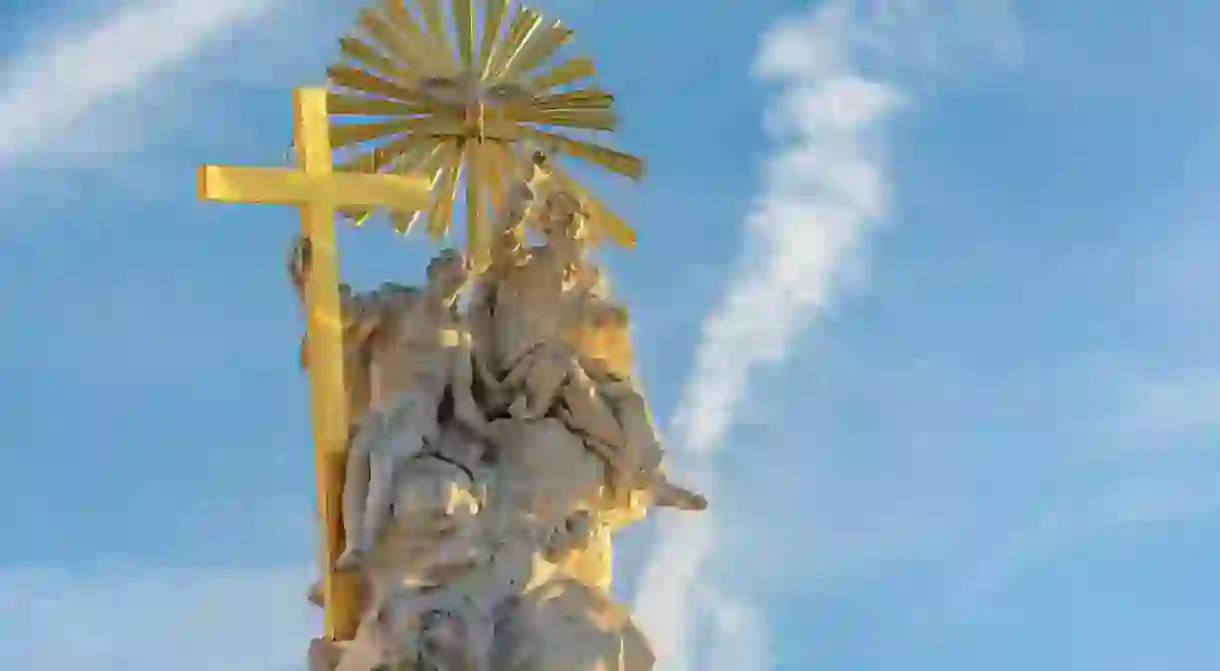The Most Beautiful Sculptures in Vienna

There is statue or sculpture on almost every corner of Vienna, often dedicated to a famous resident of the city, an Habsburg Emperor, or a particular event. With this guide, we show you the most beautiful and culturally important sculptures in the city.
Wolfgang Amadeus Mozart
Historical Landmark

This sculpture is set in the Burggarten at the Ringstrasse, and is already visible at the entrance to the park. It shows the famous Austrian composer Wolfgang Amadeus Mozart, who lived from 1756-1791. The sculpture is made of Laaser marble from South Tyrol in Italy, and the stairs are made from diorite. This memorial portrays the musician with his music stand on a decorated pedestal. The figures on the side of the pedestal show the might of Mozart’s music and point to the art nouveau movement. On the flat relief below, there are scenes from his opera Don Giovanni. And on the back of the sculpture, you will find the little six year old Mozart with his father and sister.
The Emperor Franz Monument

The Franz Grillparzer Monument
Historical Landmark

This monument is located in the Volksgarten in Vienna and shows the great Austrian author, who is particularly famous for his dramas. It was unveiled 17 years after Grillparzer’s death in 1889, and shows the larger than life figure himself, as well as having reliefs on the left and right side. The reliefs show some scenes from the authors works. Visitors will find there the Ancestress, Medea as well as The Dream A Life. In the Volksgarten there is also the beautiful monument of Empress Elisabeth and the Temple of Theseus, which are worth seeing too.
Gestapo Memorial
Memorial

Pallas Athene
Historical Landmark

The statue of Pallas Athene, the goddess of wisdom, is five meters high and situated directly in front of the Parliament building. She was designed by the sculptor Carl Kundmann. In her left hand Pallas Athene holds a spear, and in right a little representation of the goddess of victory Nike. This sculpture is set on a fountain and is surrounded by some other figures which were created by Joseph Tautenhayn. On the left of Pallas Athene, the woman with the sword signifies the executive, and the woman with the book on the right symbolizes the legislature. The two sculptures in the front with the amphora in the middle symbolize the main rivers in Austria, the Danube and the Inn. And the mermaid in the water itself, with the shell over her head, symbolizes the cooling wet after heated debates.
Maria-Theresia Monument
Historical Landmark

The monument to the Empress, Queen and Archduchess Maria-Theresia von Habsburg-Lothringen is situated in a beautiful area in between the Museum of Art History and the Museum of Natural History. It is the most important monument to the the Habsburg monarchy in the city. It was built over a 13 year period by Kaspar von Zumbusch, and revealed in the presence of the Empress Elisabeth, ‘Sissi’, in 1888. This monument is about 19 meters high and shows Maria-Theresia herself, whose figure is about 6 meters high. Surrounded her are some of the Empress’ companions, such as commanders, consultants and artists, who symbolize the pillars of her reign. Maria-Theresia was, and still is, an important personality for Austria, as she introduced many important reforms like compulsory schooling.
Memorial of the Republik
Memorial

Archduke Karl

Johann Strauss Junior
Historical Landmark
This sculpture shows the ‘King of Waltz’, Johann Strauss Junior. Visitors will find it in the City Park of Vienna, together with the beautiful figures of Johannes Brahms, Franz Schubert, Franz Léhar and Hans Makart. The gold-plated statue of Johann Strauss is the most photographed in Vienna, and is known around the world. Johann Strauss Junior’s Monument was revealed in 1921, and at first it was criticized by the city’s population as it was seen as outmoded. 14 years later the gold plate was removed, but in 1991 it was returned to its original form.
The Plague Column
Historical Landmark

Many plagues ravaged Vienna during its history, but the worst one was in 1679, when thousands of people died. The Plague Column was created to commemorate this tragedy, and was set in the now famous Graben Street. It is a Holy Trinity Column in a baroque style, and shows a lot of different figures. The most important and best known one is the Dear Augustin. They say that Markus Augustin, extempore poet, bagpiper and balladeer, survived one night in a plague pit. He was put there after he was pronounced dead, and, after he shook off the illness, he shouted and sang to get free. So he symbolizes this special relationship between Vienna and death, and that death cannot defeat the city.
See more than just the best statues of Vienna!
Historical Landmark

Beautiful statues can be seen throughout Vienna, but there’s much more to discover! Explore opulent palaces, secret courtyards, and medieval alleyways brimming with intriguing tales. You can easily discover the city’s artistic and historical riches with guided walking tours and interactive cultural events. Discover more about Vienna’s rich history and lively environment with guided tours.













